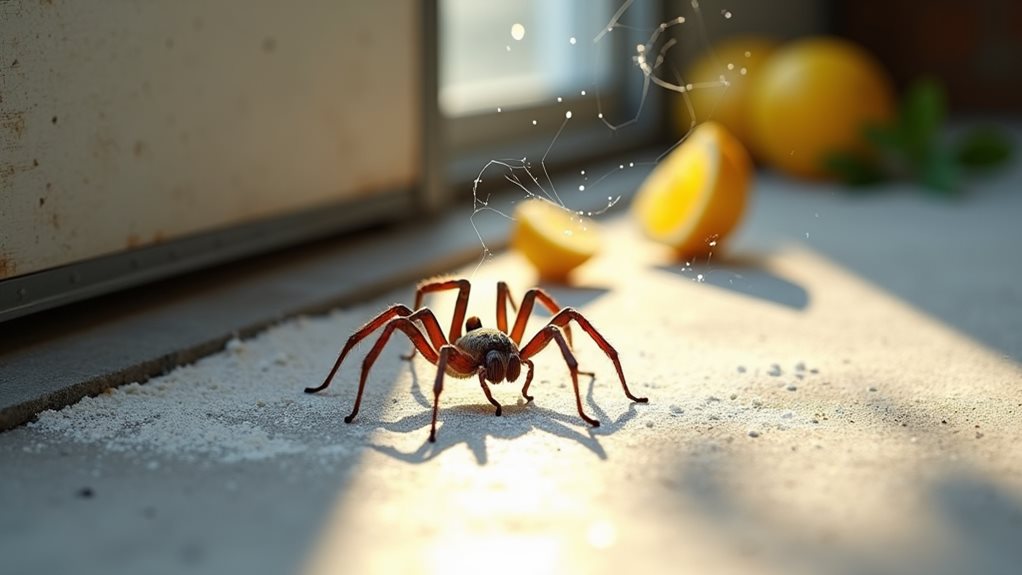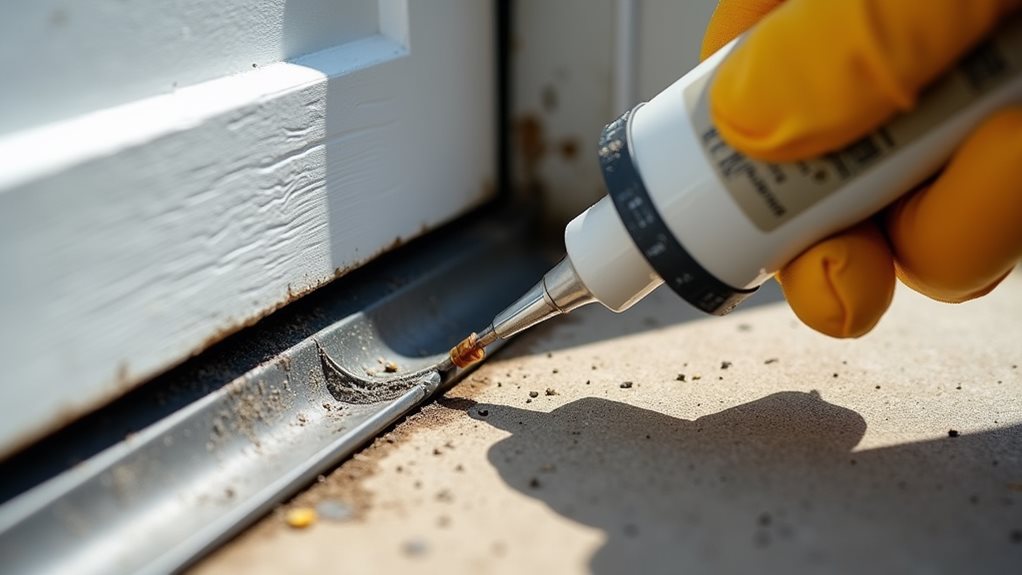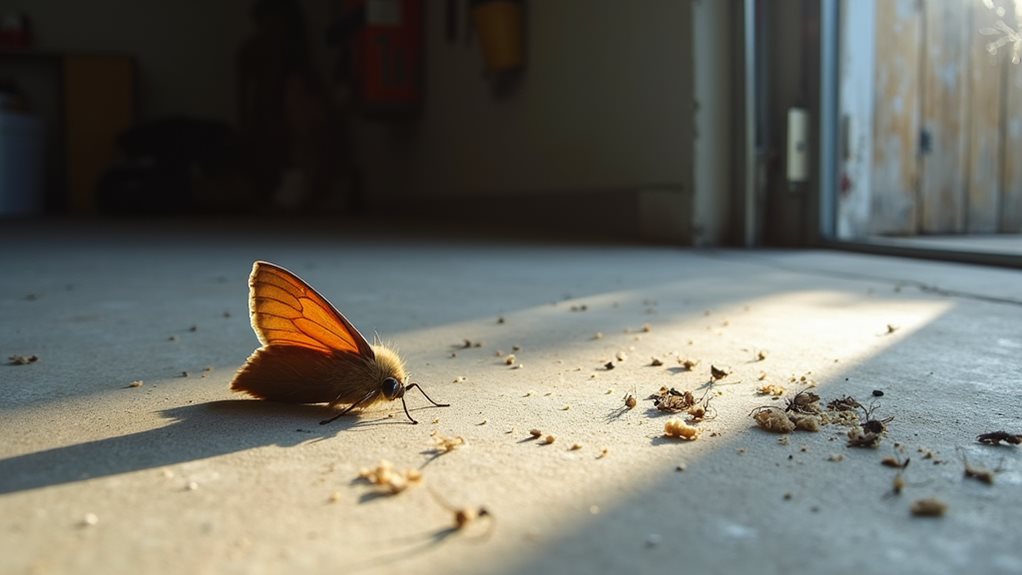To keep spiders out of your garage, start by sealing all gaps and cracks around doors, windows, and utility entries with weather stripping and caulk. You'll need to declutter the space and store items in sealed plastic containers to eliminate potential hiding spots. Regular cleaning, including sweeping and vacuuming webs, combined with natural deterrents like peppermint or tea tree oil, can considerably reduce spider presence. Focus on managing insect populations, as they're a primary food source for spiders, and maintain proper lighting with yellow-tinted bulbs. These foundational steps create an effective spider prevention strategy, though additional methods can enhance your results.
TLDR
- Seal all entry points around doors, windows, and utility lines using weather stripping and caulk to prevent spider access.
- Remove clutter and organize items in sealed plastic containers to eliminate potential hiding spots and nesting areas.
- Use natural deterrents like peppermint oil, tea tree oil, or lavender around garage entry points and corners.
- Maintain regular cleaning routines including sweeping, dusting, and removing spider webs to discourage spider habitation.
- Install motion-activated lights and reduce moisture with proper ventilation to create an environment less attractive to spiders.
Understanding Spider Behavior

Three key behaviors make spiders predictable garage inhabitants: web-building, hunting, and seeking shelter.
You'll find them creating webs in corners and rafters, as they're searching for insects to catch. Spiders are particularly effective at catching insects due to their web-building abilities, which they use to ensnare prey.
They're drawn to your garage because it offers protection from extreme temperatures and predators, while providing dark, quiet spaces where they can establish their territory and find reliable food sources. The abundance of clutter and storage in most garages creates perfect hiding spots for these eight-legged creatures.
Common Garage Entry Points
Your garage's door frames and utility line access points serve as prime entry routes for spiders seeking shelter.
These eight-legged visitors can squeeze through gaps as small as 1/4 inch, making seemingly insignificant openings around door frames particularly inviting entry points. To further deter these unwanted guests, it is essential to seal gaps and cracks around your garage.
Openings where electrical lines, plumbing, and other utilities enter your garage create additional access points that spiders regularly exploit, especially during seasonal changes when they're actively seeking indoor spaces. Installing high-quality door weather stripping can significantly reduce spider access through these vulnerable areas.
Gaps Around Door Frames
When spiders invade your garage, they often sneak through gaps around door frames – one of the most common entry points.
These openings can develop from normal wear and tear, foundation settling, or deteriorating weather stripping. Professional inspection services can help identify hard-to-spot entry points that homeowners might miss.
You'll need to regularly inspect your door frames and seal any gaps using door sweeps, weather stripping, or caulk.
Don't forget to check for damaged seals that require replacement.
Utility Line Openings
Beyond door frames, spiders frequently exploit utility line openings to enter your garage.
You'll find these entry points where electrical, gas, and water lines penetrate your walls. To prevent spider infiltration, seal all gaps around utility lines with caulk or expandable foam, and don't forget to inspect these areas monthly. Using weather stripping around these openings provides an additional barrier against spider entry.
Keep the surrounding space clear of debris and fix any moisture issues to reduce spider attraction.
Sealing Gaps and Cracks

Begin your spider prevention efforts by thoroughly inspecting your garage for common entry points, including gaps around windows, pipe outlets, and foundation cracks that provide easy access for these eight-legged visitors.
Next, you'll want to install new weather stripping around windows and doors, ensuring a tight seal that prevents spiders from squeezing through even the smallest openings.
For maximum protection, replace worn garage door seals with new, flexible rubber strips that conform tightly to your garage floor, effectively blocking spiders from crawling underneath. Additionally, sealing gaps can also help improve air quality by reducing the entry of outdoor pollutants into your garage.
Inspect Common Entry Points
Since spiders can squeeze through the tiniest openings, inspecting and sealing common entry points is essential for keeping them out of your garage.
Start by examining your garage walls for cracks and gaps, paying close attention to areas around doors, windows, and utility lines.
Don't forget to check skylights, vents, and the garage door seal, which often develop gaps that spiders can exploit.
Weather Stripping Installation Guide
Installing proper weather stripping stands out as one of the most effective ways to seal off spider entry points in your garage.
Start by thoroughly cleaning the door frame and removing any old weather stripping. Measure the gaps carefully, then cut your selected weather stripping to size.
Apply the material following manufacturer guidelines, ensuring it's properly compressed when the door closes.
Test the seal repeatedly to confirm effectiveness.
Door Seal Replacement Steps
A worn-out door seal creates an open invitation for spiders to enter your garage.
To replace it, first disable your garage door opener and remove the old seal using a utility knife. Measure your door's width, cut a new rubber gasket to size, and lubricate it with warm, soapy water.
Install the gasket into the bottom track, secure it firmly, and test the door's operation.
Natural Spider Deterrent Methods
Natural remedies offer an environmentally friendly approach to keeping spiders out of your garage.
You'll find essential oils like peppermint, tea tree, and lavender particularly effective when mixed with water and sprayed around entry points. Additionally, you can plant deterrent herbs such as rosemary and mint around your garage, while placing citrus peels or crushed horse chestnuts in corners will naturally discourage spider activity. Moreover, using natural insect repellents can help in creating a barrier against other pests that may invite spiders indoors.
Declutter Your Garage Space

Your garage serves as an ideal spider habitat when it's filled with clutter, unused items, and disorganized tools that create multiple hiding spots.
By organizing your tools and equipment into designated storage zones using shelves, pegboards, and labeled containers, you'll eliminate the dark, cluttered spaces where spiders thrive.
Removing unnecessary items and maintaining an organized system not only makes your garage more functional but also reduces the environmental conditions that attract spiders and other unwanted pests.
Organize Tools and Equipment
Inside well-organized garages, spiders have fewer places to hide and build webs.
You'll want to store your tools and equipment in plastic bins with secure lids, replacing any cardboard boxes that can attract insects.
Install shelving units and cabinets to keep items off the floor, and make use of vertical space with overhead storage.
Label everything clearly for easy identification and quick access.
Create Storage Zones
Effective storage zones are essential for keeping spiders at bay in your garage.
Start by sorting your items into clear categories like tools, seasonal decorations, and sports equipment, then designate specific areas for each group.
Place frequently used items at eye level, while storing seasonal items on higher shelves, and use labeled containers to maintain organization and minimize hiding spots for spiders.
Remove Unnecessary Items
Since spiders thrive in cluttered environments, removing unnecessary items from your garage is an essential step in spider prevention.
Start by discarding obvious trash, broken items, and unused equipment, then tackle one area at a time to maintain focus.
Group similar items together to identify duplicates and make informed decisions about what to keep, while ensuring everything you retain serves a clear purpose.
Proper Lighting and Ventilation
Throughout your garage, proper lighting and ventilation serve as powerful deterrents against spider infestations.
Install motion-activated lights and yellow-tinted bug lights to minimize insect attraction, and keep the space well-lit during active hours.
Guarantee proper ventilation through screened windows and vents, while maintaining a dry environment with dehumidifiers.
These combined strategies will make your garage less appealing to spiders.
Managing Insect Food Sources

Controlling the spider population in your garage starts with eliminating their primary food source: insects.
Keep your garage dry by fixing leaks and using dehumidifiers, while storing food in sealed containers and removing garbage promptly.
Install screens on windows and vents, replace cardboard boxes with plastic containers, and use yellow outdoor lighting to minimize insect attraction to your garage space.
Essential Cleaning Practices
Regular cleaning practices serve as your first line of defense against spider infestations in your garage.
Focus on sweeping floors thoroughly and dusting all surfaces to eliminate webs and debris.
You'll need to vacuum thoroughly, including high and low spots, while ensuring you remove any moisture or spills immediately.
Store items in sealed containers and keep the floor clear to minimize potential hiding spots.
Year-Round Prevention Strategies

A thorough approach to spider prevention requires implementing multiple strategies that work together throughout the year.
Install yellow or sodium vapor lighting outside your garage to minimize insect attraction, and maintain a consistent cleaning schedule using citrus or peppermint-based solutions.
Keep vegetation trimmed away from your garage's exterior, and regularly inspect seals around doors, windows, and utility entry points for necessary repairs.
Professional Pest Control Options
While DIY methods can help manage spider populations, professional pest control services offer thorough solutions for persistent garage spider problems.
Their extensive approach includes thorough inspections to identify spider species and nesting areas, targeted treatments with specialized pesticides, and sealing of entry points.
They'll also implement ongoing monitoring systems and provide regular maintenance visits to guarantee long-term spider control effectiveness in your garage.
And Finally
By implementing these spider control strategies consistently, you'll create an environment that's far less appealing to arachnids. Remember that effective spider management requires a multi-faceted approach, combining physical barriers, natural deterrents, and regular maintenance. While you can't eliminate spiders completely, you'll greatly reduce their presence by sealing entry points, removing their food sources, and maintaining a clean, organized garage space. These methods, when used together, provide long-term spider control success.